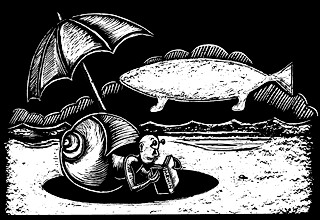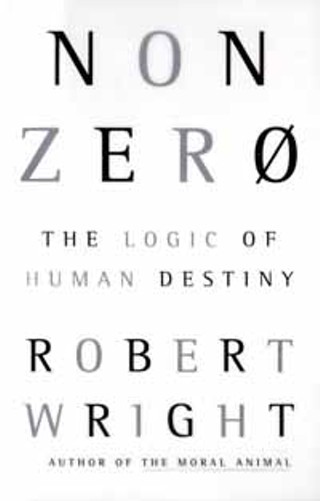An Immense World of Delight
Where in the World Is Mother Nature?
By Roger Gathman, Fri., June 30, 2000

Nonzero: The Logic of Human Destiny
by Robert WrightPantheon, 435 pp., $27.50
Darwin's Ghost: The Origin of Species Updated
by Steve JonesRandom House, 377 pp., $25.95
A Plague of Frogs: The Horrifying True Story
by William SouderHyperion, 304 pp., $23.95
Sensory Exotica: A World Beyond Human Experience
by Howard C. Hughes
MIT Press, 344 pp., $26.95
The British biologist J.B.S. Haldane was once asked what he could infer about God's plan from the design of nature. He reportedly answered that God must have "an inordinate fondness for beetles." That's because there are, by some estimates, around 400,000 beetle species described so far, and it is estimated by some that there may be as many as 7,000,000 left to describe. To put it another way, every fourth animal on earth is a kind of beetle. Yet nobody calls this the Age of Beetles, and therein lies the gap between the biologist's perspective and the popular one. Simply put, the biologist can't afford to be anthropocentric, but the human in him or her can't afford not to be. So we cling to a popular notion of dominance, in which the Age of Fishes gives way to the Age of Dinosaurs, which in turn gives way to the mammals, as if we were all on a ladder. And, of course, within the Age of Mammals comes the Age of that rookie recently arrived (a mere million and a half years ago) from the African jungle, Homo sapiens. All of the books in our roundup touch, to one extent or another, on the human considered purely as animal. He's our favorite animal, of course, being us. For a long time he was considered not to be an animal at all, in spite of the evident similarity of man to beast, from his nipples to his toenails, and from his birth and breathing to his death and decay. There's a bit of a difficulty, then, in calling this an article about "nature" books -- after all, in a sense, every book is about nature. The problem is that there are two meanings that are attached to "nature," and they are slightly and surreptitiously at cross-purposes. We can use nature to describe the class of all living and nonliving things, as when we talk about the laws of nature, or we can give the word less reach, and designate just those things that aren't human. In the first meaning, making plastic or making nests are equally natural activities performed by animals, but according to the second meaning, they aren't. It's a semantic car wreck, and though I'm going to write about nature in the more extensive denotation, it is impossible to clear one's mind completely of the idea of human exceptionalism.
The first writer on the list, Robert Wright, is famous for writing a book, The Moral Animal: Why We Are the Way We Are: The New Science of Evolutionary Psychology, which supposedly tried to pierce the aura of the idea of human exceptionalism to bring us in line with other beasts. Of course, other beasts possess habits that have evolved from their species' nature, so Wright's idea is that we do too. Wright is an ultra-connected journalist, and The Moral Animal made a Time magazine cover -- which signals an awesome status in the realm of punditry, the equivalent of "making your bones" in the Mafia.
His newest book, titled, rebarbatively, Nonzero, is a veritable pundit's cosmology. Wright gives us a breezy history of humanity, which he embeds in a breezy history of life itself, which he then embeds in a breezy mysticism. Wright's astounding feat is to have embodied the conventional wisdom of his time. He is the Clinton Era, the Third Way, the IPO age, turned into a world-view.
That he seems to be a bit of a boob doesn't make him any less instructive.
This leads to a different endowment of genetic matter for the different sexes of the ants, which leads to a greater degree of relatedness between sisters than between the sister and the mother, or the brother, or the offspring. This central fact, Hamilton discovered, is a sort of default controling the behavior of the ants. A female ant might well sacrifice her ability to reproduce in order to further the queen ant's production of more female ants. Although Hamilton latter conceded that there were levels of survival, the primary one, in his view, was on the level of the genes. The genes are, so to speak, the markers of success. On this level, the male ants, which embody a lesser genetic relationship, are relatively disposable. No need to sacrifice for them -- in fact, the sneaky females destroy many of those eggs that are unfertilized (which are male, you will remember), so that males are usually outnumbered three to one by the females. And they can also be sent out to do the risky tasks, with no genetic compunction, so to speak. The balancing of sacrifice against the accrual of benefit among the ants works itself out, also, among other, less sexually complicated creatures. It used to be a commonplace of moralists that man was the only creature in the animal kingdom to slaughter his own kind, but, in fact, kind is slaughtered by kind routinely among ants, salamanders, and, as any child can tell you, guppies. The golden rule, in nature, is not "do unto others" -- it is "why waste the protein?"

The calculation of benefit and loss which unlocks the logic of the behavior of ants is at the heart of game theory, which mathematically models the concept of winning and losing. The execrable businessman's phrase, "win-win," is distantly derived from this elegant little sub-discipline. What Hamilton had done is find a way to make the issue of altruism mathematically respectable: If the sacrifice of a member of a group for another member of the group could lead to a genetic benefit, altruism can be "selected for" within the struggle for existence.
Wright had the good sense not to title his book Win-Win, but the concept of nonzero-sumness is similar, except that Wright reifies a simple notion in game theory into an actual life force.
Wright's book is built on four arguments. First, he contends that evolution has a distinct direction, in favor of greater complexity. Second, he contends that human history, in its larger features, recapitulates nature -- that is, that society goes from less complexity to more. Third, he contends that the principle of that complexity is nonzero -- an interested cooperation among competitors. Four, he concludes that we (humans) are building a world organism.
Complexity becomes even more tricky once you apply it, as Wright does, to human societies. Wright's idea is that you can see a developmental trend from less complex societies, like the Shoshone-Paiute of the Great Basin, to more complex societies, like us. All of human history can be envisioned as a big cake, out of which we, history's showgirl, jump.
Now, I was curious about how the Shoshone ended up near the base of the complexity tree. So I looked up the essay by Robert Carneiro from which Wright apparently gets his scale for complexity. I immediately saw why the Shoshone didn't make the grade. Carneiro has criteria like tithing and building monumental structures. Which the Shoshone certainly didn't do. The Mormons, who moved onto their territory, did both, as anybody who goes to Salt Lake City and sees the temple there can testify.

But wait a minute. Consider that the Shoshone, in a landscape that is generally conceded to be one of the most barren in the continental USA, did manage to feed themselves on about 97 different seeds -- from grass seed to the piñón nut. And consider that the Mormons, way up there in the complexity scale, supplanted them with a cattle-grazing culture. That culture did succeed in starving out the Shoshone, whose attempt to kill the cattle was ferociously discouraged by the U.S. Army. But the cattle soon overgrazed the range. The Mormons next tried irrigation and crops, meeting Wright and Carneiro's approval, but the irrigation not only brought poisonous minerals up from the ground -- salts and arsenic -- leading to a collapse of the farmers' economy in the Thirties and, consequently, the decline and fall of this culture, eased by federal subsidies. The Mormons were replaced by two Nevada mainstays, gambling and prostitution. It is true that the former elevates monumental structures, but neither gamblers nor whores are renowned for tithing.
My skepticism about nonzero-sumness and its role in the history of the universe grew into outright incredulity at the end of the book, when Wright invokes everything from Teilhard de Chardin's noosphere to the bull market of the Nineties to proclaim the dawning of the planetary consciousness. This part of the book is littered with howlers, among which my favorite is: "All in all, the shape of life on this planet is now moving so fast via cultural evolution that evolution by natural selection is, for practical purposes, standing still." This is such breathless nonsense that it is admirable. To compare cultural evolution to natural selection is like comparing the runner to the track: The runner is moving faster, but the track always somehow gets there before him.
I turned with relief from Wright's biomystical extravaganza to Steve Jones' Darwin's Ghost. For Wright, man is the summit of creation and evolution's finest hour. For Jones, man is a bit less god-like. After all, he writes, "Just a tenth of the cells in our body are human. Most of the rest belong to bacteria (although a few fungi, mites and worms leaven the mix)." Those sentences, with the last sentence's wonderfully mordant parenthetical modification, should give you a sense of Jones' style. One has the urge, while reading Wright, to exclaim "Down puppy, down!" every five pages or so. Jones, on the other hand, exudes the good humor of a successful pathologist completing a particularly fascinating autopsy. His style is almost too literate for the sciences. Take this paragraph, about "rudimentary, atrophied or aborted organs":
A glance around the world shows general decay: parasites reduced to sacks of guts and genitals, useless organs such as the human appendix, and great stretches of DNA that make no protein. The sea squirt, after an active life, settles on the sea floor and, like a professor given tenure, absorbs its brain.
Noosphere be damned, this book is the real thing.

Jones is a zoologist, and it is tempting to think that the inspiration for the book came from the hermit crab. The hermit crab takes an abandoned shell and literally adopts it as its own. Jones takes Darwin's Origin of the Species, perhaps the most influential book of modern times, and settles down within it, using Darwin's chapter and subchapter headings to organize his story. His story is how evolution, through the mechanism of natural selection among variations that adapt with more or less success to environments, operates to create all the living forms we see around us, and all the ones that we don't see, too. One would expect this work to have a strong historic element -- you know, the first-comes-Darwin-then-comes-Mendel plot we all know vaguely from high school -- but Jones is not at all interested in doing intellectual history. He's really interested in nature. He has compressed an encyclopedia's worth of facts and theories from geology, paleontology, molecular biology, epidemiology, and so on to give the lay reader a general picture of natural history.
Of course, evolution is very much in the news now, with claims about this or that evolutionary explanation of human behavior. Jones doesn't comment directly about evolutionary psychology, but he is pretty abrasive about its cousin, sociobiology. Since, as he points out, "man and aardvark are unique among animals as solitary species, each within a single genus," we shouldn't draw evolutionary conclusions from comparisons with unrelated species for either of them. I myself think that is a little extreme, but it does need to be said as a reminder that all evolutionary explanations have to take into account the peculiarities of the creature evolving.
Jones takes it for granted that all creatures great and small are caught within the meshes of the great evolutionary machine. He begins the book with the story of one of those creatures -- the HIV virus. As he points out, its adaptations have, so far, been spectacularly successful. Since they so painfully impinge upon us, we have a clearer picture of how that virus has changed over the mere twentysomething years since it was identified. Here, there is no longer any question of treating evolution, as the creationists insist, as one theory among many; not understanding the evolutionary mechanism at work with this virus would be an act of gross stupidity. Unfortunately, the same is true about genetically altered plants, much as the scientists busy pouring them out would like to bury that fact. As Jones points out: "The engineers deny the central fact of evolution: that the action of a gene can depend on the species in which it finds itself and that all species were once varieties (which means that the boundaries between many can still be breached)." It is important to remember that scientists have interests, especially the ones that stand to make a deal of money patenting gene sequences, and those interests can make them the unconscious allies of the creationists, denying an evolutionary fact for immediate gain.
As with any general book on natural history, the fun for the reader is in the number of odd facts, good for quoting in bars. Among the facts to be treasured from Jones' book: that the male Dyak fruit bat is the sole mammal to use its nipples for a purpose other than the erotic, by giving suck to its young; that the village weaverbird, in Africa, rejects most cuckoo eggs, but since it was introduced to America, seems to have lost its ability to recognize them; that the female hyena possesses a clitoris of a size equal to her male partner's penis, and for intercourse she "rolls it back, rather like a man might roll up the sleeve of his shirt"; that the male gorilla, on the other hand, has a "guilty secret": his one-and-a-half-inch member. This selection, of course, doesn't do any justice to what is contained in Jones' book, where the facts are manifold and frequent.
Yet the main reason to read the book isn't for the sake of such intellectual curios. The main reason is that Jones, like Richard Dawkins in The Selfish Gene, achieves the Darwinian sublime. I am always after that in a nature book.

The sublime, as you know, is that aesthetic feeling that results from the sequence of contemplating some object physically much greater than you, and then contemplating your contemplation of that object. The sublime was much in vogue among the Romantic poets, who were always going to Mount Blanc to get a taste of it, or watching sunsets with appropriate melancholy. The Darwinian sublime is achieved by contemplating that train of variations and extinctions which constitute the long history of life on this planet. It stands to reason that, among the kinds that will eventually falter and fail, we should include our own species. But we can contemplate, at least, our contemplation, and get a certain rush. Even out of the grimmest details of the HIV virus we can appreciate, with the intellectual side of our brain, the sheer ingenuity of the natural mechanism.
The sublime needn't paralyze us, however. As we all know, this is the age of extinctions. And as we all know, there's a culprit -- ourselves. I picked up William Souder's A Plague of Frogs thinking that it would be another report on the encroachment on our countryside on the order of Silent Spring. It turned out to be a bit different.
On August 8, 1995, in Le Sueur, Minnesota, a class field trip to a local wetlands pond stumbled upon a great mass of deformed frogs. This was the first report of a great outbreak of frog deformities throughout Minnesota, and in Quebec and Vermont too. The deformities were mainly extra limbs or not enough limbs, although there were also some incredibly odd ones. Souder has a photograph of a frog which was born with an eye growing in its mouth.
The immediate assumption was chemicals. Somehow, some pesticide was injuring the developmental pathway of the frog. That, at least, was what most of the scientists at the EPA, the National Health Institute, and the Minnesota environmental agencies thought. However, an outside scientist, Stan Sessions, thought that the developmental problems were caused by a parasite of the trematode family.
Souder's story has the overtones of pop myth. Le Sueur is the home of the Jolly Green Giant. That's right, Pillsbury has a factory there. So, for all practical purposes, Little Sprouts in the Valley were stumbling upon little aberrant sprouts in frogs. Which isn't good, or wholesome.

The end of the story is that Sessions was vindicated, or at least to a large extent. After four years of research, scientists finally did find the trematode cysts in the frogs. But along the way they also discovered that UV rays could cause developmental injuries. Souder's book ends on a rather undecided note about the whole affair.
The subplot of this book, however, is as interesting as the plot. As species crash across the planet, there is a parallel crash in the diversity of biologists. The molecular biologists rule, and, increasingly, field biology, which actually goes out and looks at plants and animals, is becoming an anachronism. The field biologists Souder interviews, who have been out in wetlands and creeks, are pretty much unanimously pessimistic about the environment. That is, they believe that the environment we've known for the last 10,000 years is gone.
Now, as Jones points out, extinction is an estimable part of the natural order. Sixty-five million years ago, for instance, it is estimated that 70% of the species on earth were extinguished as the result of an asteroid that socked into the Yucatán peninsula. From soil samples that have been taken in North and South America, we know that the forest cover, almost all of it, burned -- which is a conflagration of unimaginable size. There was a heat spike following the meteor crash, and ground temperatures might have gone up to 400 degrees Fahrenheit.
Still, I prefer the bang of the last big species crash to the whimper of the present one.
As an example of what is being lost, I recommend Sensory Exotica by Howard C. Hughes. Biodiversity also means perceptual diversity. This book put me in mind of one of my favorite verses of William Blake: "How do you know but ev'ry Bird that cuts the airy way/Is an immense world of delight, clos'd by your senses five?"
That said, Blake also wrote: "He who shall hurt the little Wren/Shall never be beloved by Men." It is probable that Blake would not have liked Lazzaro Spallanzani, his Italian contemporary, who was the first to suggest that bats relied on hearing to navigate. He came to that conclusion after "thrusting red-hot wires" into their eyes.
Hughes' book begins with a chapter on echolocation in bats, and hence Spallanzani. It wasn't until this century that Spallanzani's suggestions were taken up (ironically, zoologists of the day took offense at his cruelty to bats, and proceeded to ignore his suggestions). The faculty of echolocation is not, of course, confined to bats -- it is also one of the sensory modalities of the dolphin. Hughes explores how birds get their sense of direction (which may have to do with sensitivity to the earth's magnetism), how electric eels sting, and how pheromones work. Hughes has an odd tendency to slip from a genial lecturing tone to technical discussions of the vomeronasal organ in human beings. But it is certainly worth the effort to keep up with him, skipping the parts where he becomes particularly dense. If there really is an environmental ethics, surely the place to begin is with an appreciation of the sensory worlds of other creatures, and Hughes has made them at least theoretically accessible to us.
It is a bit ironic, though, that just as we are just finding out how rich those worlds are in all their secret blisses and complications, they are dying, all over the world, in great masses. As Souder writes, "The question isn't whether many of the world's more than 4,000 amphibians species are disappearing ... but rather why they are." In his classic book, The Song of the Dodo, David Quammen quotes from a biologist, Dan Simberloff, who claims that the current rate of extinction is among the worst half-dozen to have occurred in the entire history of the planet. The human event, in other words, is becoming the equivalent of an asteroid hit on earth's surface. Americans in particular, who are born to a degree of power unimaginable even a mere hundred years ago, might want to consider the consequences of lifestyles which require, for each of us to get through our normal day, as much energy as is used by the sperm whale. The sperm whale weighs about 40 tons. Americans talk about obesity, but in ecological terms, the real problem is this deep obesity, the structural obesity built into our lives, which is condemning those marvelous sensory worlds proper to all manner of swimming, creeping, and flying beasts to irreversible nothingness. Blake was talking about the class consequences of the Industrial Revolution for human beings when he wrote "Auguries of Innocence," but today the tragic divide upon which these lines brood has expanded to biomass itself:
Some are Born to sweet delight,
Some are Born to Endless Night. ![]()








